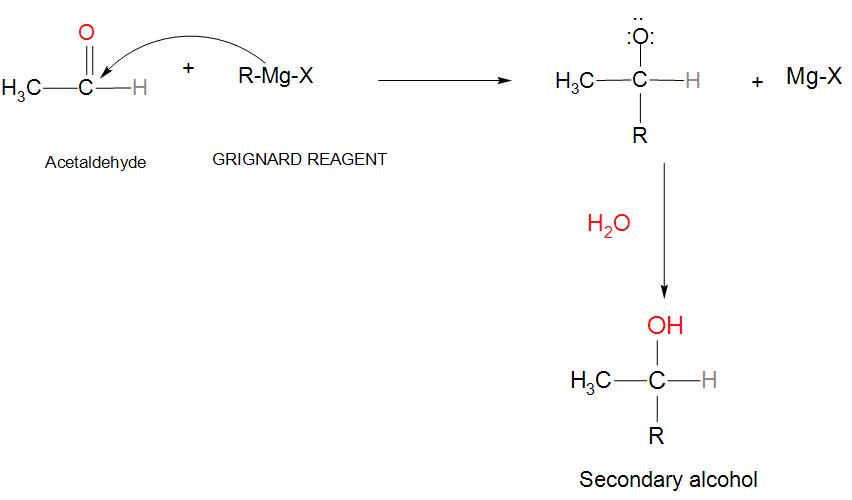
Aldehydes other than formaldehyde react with Grignard’s reagent to give addition products which on hydrolysis give:
A. tertiary alcohols
B. secondary alcohols
C. primary alcohols
D. carboxylic acids
Answer
420.6k+ views
Hint: Aldehyde reacts with Grignard’s reagent to give organometallic compounds. Which on further hydrolysis gives alcohols. Grignard’s reagent is magnesium alkyl halide, which is formed when alkyl halide is reacted with magnesium.
Complete answer:
- We will take an aldehyde like acetaldehyde and react it with Grignard reagent then it will give additional products, which on hydrolysis will give secondary alcohol. We can see the reaction:

- If we take an Aldehyde like acetaldehyde and when it reacts with Grignard’s reagent (that is an alkyl halide mixed with Mg). We can see that the carbonyl carbon of acetaldehyde is having positive charge and the oxygen is having negative charge.
- When it is attacked with Grignard reagent, at that time it will push the double bond between carbon and oxygen to become a lone pair around the oxygen, and we get the product along with Mg-Halide.
- In the next step the products are mixed up with some aqueous acid and we get a secondary alcohol as our main product.
Hence, we can conclude that option (B) is correct, that aldehydes other than formaldehyde react with Grignard’s reagent to give additional products which on hydrolysis give secondary alcohols.
Note:
- All the aldehydes except formaldehyde when reacted with Grignard’s reagent will give secondary alcohol. Formaldehyde will give primary alcohol.
- Ketones also react with Grignard’s reagent to give alcohol.
Complete answer:
- We will take an aldehyde like acetaldehyde and react it with Grignard reagent then it will give additional products, which on hydrolysis will give secondary alcohol. We can see the reaction:

- If we take an Aldehyde like acetaldehyde and when it reacts with Grignard’s reagent (that is an alkyl halide mixed with Mg). We can see that the carbonyl carbon of acetaldehyde is having positive charge and the oxygen is having negative charge.
- When it is attacked with Grignard reagent, at that time it will push the double bond between carbon and oxygen to become a lone pair around the oxygen, and we get the product along with Mg-Halide.
- In the next step the products are mixed up with some aqueous acid and we get a secondary alcohol as our main product.
Hence, we can conclude that option (B) is correct, that aldehydes other than formaldehyde react with Grignard’s reagent to give additional products which on hydrolysis give secondary alcohols.
Note:
- All the aldehydes except formaldehyde when reacted with Grignard’s reagent will give secondary alcohol. Formaldehyde will give primary alcohol.
- Ketones also react with Grignard’s reagent to give alcohol.
Recently Updated Pages
The correct geometry and hybridization for XeF4 are class 11 chemistry CBSE

Water softening by Clarks process uses ACalcium bicarbonate class 11 chemistry CBSE

With reference to graphite and diamond which of the class 11 chemistry CBSE

A certain household has consumed 250 units of energy class 11 physics CBSE

The lightest metal known is A beryllium B lithium C class 11 chemistry CBSE

What is the formula mass of the iodine molecule class 11 chemistry CBSE

Trending doubts
State the laws of reflection of light

Arrange Water ethanol and phenol in increasing order class 11 chemistry CBSE

One Metric ton is equal to kg A 10000 B 1000 C 100 class 11 physics CBSE

Difference Between Prokaryotic Cells and Eukaryotic Cells

A mixture of o nitrophenol and p nitrophenol can be class 11 chemistry CBSE

How do I convert ms to kmh Give an example class 11 physics CBSE




